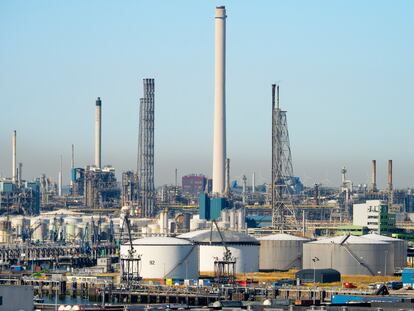Methane emissions from energy sector remain at historic highs, fueling climate crisis
The International Energy Agency points out that some countries, such as the U.S. and Canada, have already approved plans to reduce emissions of this powerful greenhouse gas


Methane (CH₄) emissions from the global energy sector reached record levels last year, according to data provided by the International Energy Agency (IEA) on Wednesday. Until recently, international climate agreements did not focus on this powerful greenhouse gas, even though it is responsible for around 30% of the rise in global temperatures since the Industrial Revolution. In 2021, coinciding with the U.N. Climate Change Summit in the Scottish city of Glasgow, 100 countries forged an alliance that committed to reducing global methane emissions by 30% in 2030.
Experts believe the energy sector is where it is easiest to achieve major reductions in methane emission — the other sectors that are major emitters are agriculture and livestock. However, despite the succession of announcements and commitments in recent years, methane emissions from fossil fuels continues to rise, which in turn, is fueling the climate crisis.
The International Energy Agency estimates that the production and use of fossil fuels put more than 120 million tons (Mt) of methane into the atmosphere in 2023. The oil industry accounted for the highest emissions — 50 Mt — due to extraction and transportation operations. It was followed by coal (40 Mt) and natural gas (30 Mt). Another 10 Mt was from bio energy. According to the IEA report, methane emissions in 2023 were up from 2022, reaching 2019 levels, when they reached a record high.
“It is essential to reduce emissions,” Christophe McGlade, head of the Energy Supply Unit of the IEA, the department responsible for the methane study, warned in a virtual meeting with the international press.
Despite the numbers, the IEA remains optimistic. “Efforts to cut methane emissions are expected to accelerate in 2024,” the report claims, pointing out that 200 countries agreed in the 2023 Climate Conference in Dubai to “substantially reduce methane emissions by 2030.”
“If all methane policies and pledges made by countries and companies to date are implemented and achieved in full and on time, methane emissions from fossil fuels would decline by around 50% by 2030,” the report states.
These pledges are already being translated into regulatory initiatives to stop methane leaks in some nations, such as the United States, Canada and the 27 members of the European Union. The problem, McGlade pointed out, is that many other countries (the majority) still do not have “detailed implementation plans” on how to comply with the commitment to reduce methane emissions by 2030, a deadline that is fast approaching.
Agriculture and fossil fuel production
Annual global methane emission are around 580 Mt. Around 40% come from natural sources, such as wetlands, while the remaining 60% is from human activity. Agriculture and livestock farming — activities such as rice plantations and beef farms — account for around 145 Mt, while the energy sector from fossil fuel production contributed 120 Mt, as calculated by the IEA.
If the most ambitious goal of the Paris Agreement is to be met — limiting the rise in global temperature to 1.5ºC compared to pre-industrial levels — the IEA estimates that methane emissions from fossil fuel operations need to fall by around 75% by 2030. The emphasis on the fossil fuel sector makes practical sense, as methane emissions typically come from well-identified sources, such as oil extraction wells or a section of a gas pipeline. Some leaks are accidental, but others are deliberate, in which methane, the main component of natural gas, is vented. In the case of coal, controlling these vents is somewhat more complicated.
The IEA report argues that methane abatement in the fossil fuel industry is one of the “lowest cost options” to tackle the problem. According to the study, “around 40% of the 120 Mt of methane emissions from fossil fuels could be avoided at no net cost, based on average energy prices in 2023.”
The report estimates that $170 billion is needed to cut methane emission from fossil fuel production by 75% by 2030, which is “less than 5% of the income the industry generated in 2023.”
China is the country with the highest methane emissions. It is followed by Russia, the United States — the main emitter if only oil and gas operations are taken into account —, Iran, Turkmenistan, India and Venezuela.
According to McGlade, satellite imagery is playing a key role in efforts to cut methane emissions, providing more “transparent” data and helping to identify and address the emissions. “They are filling gaps and uncertainties in the data by providing information that might otherwise be left out” of the public spotlight, he said. The IEA pointed to MethaneSat, a satellite launched last week that is specifically designed to detect emissions from the oil and gas industry — a project being led by the American NGO Environmental Defense Fund (EDF).
Sign up for our weekly newsletter to get more English-language news coverage from EL PAÍS USA Edition
Tu suscripción se está usando en otro dispositivo
¿Quieres añadir otro usuario a tu suscripción?
Si continúas leyendo en este dispositivo, no se podrá leer en el otro.
FlechaTu suscripción se está usando en otro dispositivo y solo puedes acceder a EL PAÍS desde un dispositivo a la vez.
Si quieres compartir tu cuenta, cambia tu suscripción a la modalidad Premium, así podrás añadir otro usuario. Cada uno accederá con su propia cuenta de email, lo que os permitirá personalizar vuestra experiencia en EL PAÍS.
¿Tienes una suscripción de empresa? Accede aquí para contratar más cuentas.
En el caso de no saber quién está usando tu cuenta, te recomendamos cambiar tu contraseña aquí.
Si decides continuar compartiendo tu cuenta, este mensaje se mostrará en tu dispositivo y en el de la otra persona que está usando tu cuenta de forma indefinida, afectando a tu experiencia de lectura. Puedes consultar aquí los términos y condiciones de la suscripción digital.
More information
Archived In
Últimas noticias
Most viewed
- Sinaloa Cartel war is taking its toll on Los Chapitos
- Oona Chaplin: ‘I told James Cameron that I was living in a treehouse and starting a permaculture project with a friend’
- Reinhard Genzel, Nobel laureate in physics: ‘One-minute videos will never give you the truth’
- Why the price of coffee has skyrocketed: from Brazilian plantations to specialty coffee houses
- Silver prices are going crazy: This is what’s fueling the rally










































